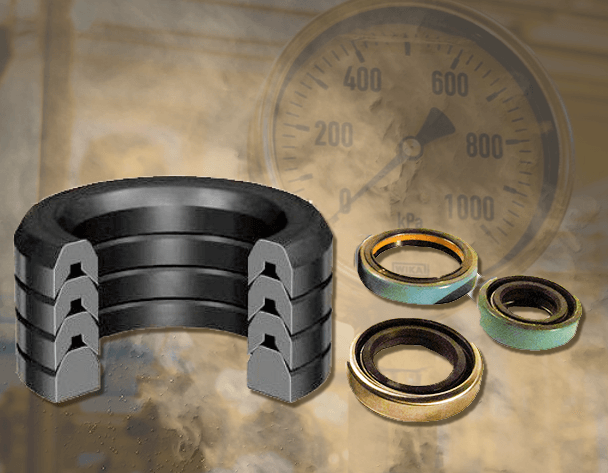In this post, the third in a series on factors influencing PTFE seal behavior, we are going to look at
dimensional effects on PTFE rotary seal behavior. We will be focusing on industry standard
recommendations for radial clearance and shaft/bore tolerances.
Factors Influencing PTFE Seal Behavior: The PV Limit – Part 2 in a 3 Part Series
The performance of a dynamic PTFE seal depends greatly on the pressure and shaft velocity involved. In reality, a seal is in contact with only a small area of rotating shaft, which means that the dynamic forces and energy are going to be concentrated there. Much of the energy that comes from the shaft is going to be dissipated in two forms: wear and frictional heat, both of which can reduce the useful life of a seal. An increase in the force that holds the seal lip against the shaft or an increase in the speed of the shaft makes the effects of wear and heat even worse.
Factors Influencing PTFE Seal Behavior: The Mating Surface – Part 1 in a 3 Part Series
The useful life of a PTFE seal is heavily influenced by the surface over which the seal slides or rotates. This includes both the material choice, surface finish, and hardness of the mating surface. In this article, we will look at how the mating surface influences the life and behavior of a PTFE seal and how to account for that effect during the design process.
5 Reasons Why PTFE Seals are an Excellent Choice for Automotive Applications
Automotive PTFE Shaft Seals
In this article, we are going to explore the reasons why PTFE seals are among the best choices for many automotive applications. Youll find PTFE seals in fuel cell seals, fuel injection pumps, steering wheel seals, air conditioning, compressor seals, hydraulic seals, and more. Were going to focus our attention on PTFE shaft seals. Lets take a look!
Want more great articles on PTFE Shaft Seals, check it out from the Engineer’s choice Advanced EMC Technologies Blog:
Critical Factors: Reverse Engineering Polymer Seals, Bellows, Diaphragms, & Bearings
What is Reverse Engineering?
Reverse engineering means to recreate a part based on available data about it. Keep in mind that the goal of reverse engineering is not so much as to create a part that looks and feels identical to the original part (although it can be), but rather provides the same (or better) performance as the original part. The material might be different. While it will likely fit in the same space envelope, non-critical geometry might not be the same. However, the part achieves the same purpose and performs the same function.
Need some more information? Check out these post on the Advanced EMC Technolgies blog:
Why Nylon Bushings are a Good Choice for the Bicycle Industry
Reinforced Nylon Bushing Option
Plain bearings in bicycle applications get subjected to a good amount of abuse, from high shock loads as the rider makes their way over uneven terrain, to potentially high speeds as some bikes can reach speeds in excess of 70 mph. Then there are the issues of environmental contaminants, namely water, mud, sand, and other debris. That means that cleaning is required, often in the form of steam. It takes a special type of bushing to stand up under these types of rigors. One of the options to consider is reinforced nylon.
For even more articles for advanced polymer bushings for the bicycle industry check out these posts from the Engineer’s choice Advanced EMC Technologies Blog:
Polymer Rear Hub Bushings: Wear Resistant Self-Lubricating Bushings for the Bicycle Industry
INTRODUCTION:
There are a variety of places where you can find composite bushings in a bicycle, including the headset, pedals, brake lever, front and back derailleurs, and the rear suspension, just to name a few. In this article, we are going to look at the bushings used in rear hubs.
Many people wrongly assume that a polymer rear hub bushing, instead of a metal one, is a cheap substitution made by hub manufacturers. Nothing could be further from the truth! Lets talk about how to select a proper material for a rear hub polymer bushing that will far outshine its metallic counterparts.
Here are some other great articles on polymer bushiings from the Advanced EMC Technologies Blog:
Fluorolon Polymer Materials for Off-Road Bikes: Carbon Fiber Reinforced PPS
PPS Bushings
There are a variety of bushings in your typical off-road bicycle, from the rear derailleurs to free wheeling hubs. These types of bikes require bushings that can handle a demanding, intense, unpredictable environment. There are a variety of materials to choose from, and in this article we are going to look at carbon fiber reinforced PPS material..
Get more information on Advanced Polymer Bushings from the design Engineer’s choice Advanced EMC Technologies Blog:
4 Reasons: PTFE Rotary Shaft Seals for Low Friction High Speed Applications
PTFE Excellent Solution
PTFE rotary shaft seals are an excellent solution to high speed applications with surface speeds up to 30 m/s. In this article, we are going to look at four reasons behind that continued popularity.
Here are some additional articels on PTFE Rotary Shaft Seals from the Advanced EMC Technologies Blog:
3 Reasons You Should Consider PEEK for High Pressure Polymer Seals
Polyetheretherketone PEEK
There are many applications that require high-pressure seals, such as down-hole safety valves, water jet intensifiers, and oil and gas valves. PEEK, short for polyetheretherketone, is a high performance engineering polymer thats a common choice for high pressure seals. Lets see why
Want to stay ahead of the curve? Check out additional articles on high performan PEEK seals from the Advanced EMC Technologies blog:
- « Previous Page
- 1
- …
- 22
- 23
- 24
- 25
- 26
- …
- 33
- Next Page »







